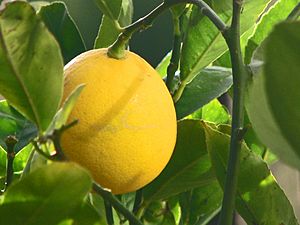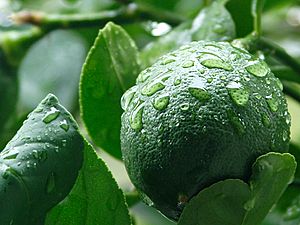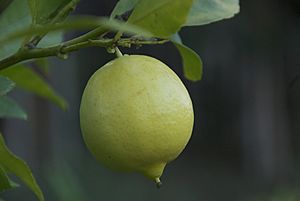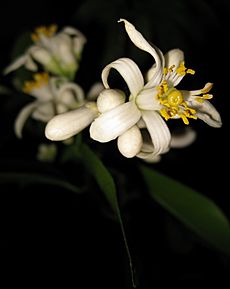Meyer lemon facts for kids
Quick facts for kids Meyer lemon |
|
|---|---|
 |
|
| Scientific classification | |
| Genus: |
Citrus
|
| Species: |
× meyeri
|
The Meyer lemon (also called Citrus × meyeri) is a special kind of citrus fruit. It comes from China. It's a mix of a citron and a mandarin or pomelo.
Meyer lemon trees usually grow about 6 to 10 feet (1.8 to 3 meters) tall. They have shiny, dark green leaves. Their flowers are white with a bit of purple at the bottom and smell very nice. The fruit looks like a round, deep yellow lemon with a hint of orange when it's ready to pick. It tastes sweeter and less sour than regular lemons you find in stores. Meyer lemons are also quite acidic, which means they can be used to clean things because they help kill germs.
An explorer named Frank Nicholas Meyer brought this lemon to the United States in 1908. He worked for the United States Department of Agriculture and found the plant during a trip to China. Even though it's named after him, this type of lemon has been around in China for thousands of years!
In China, people often grow Meyer lemon trees in pots as pretty ornamental plants. In the U.S., it became popular for cooking in the 1970s. Famous chefs like Alice Waters started using them. Later, Martha Stewart also featured them in her recipes, making them even more well-known.
Contents
What Does a Meyer Lemon Look Like?
Meyer lemon trees grow to be about 6 to 10 feet (1.8 to 3 meters) tall. You can also trim them to keep them smaller. Their leaves are a dark green and look shiny. The flowers are white with a purple base and have a lovely smell.
The Meyer lemon fruit is yellow and rounder than a regular lemon. Its skin smells good and is thin. When ripe, the skin is a deep yellow with a slight orange color. Meyer lemons taste sweeter and less sour than common lemons like the Lisbon or Eureka kinds. The inside of the fruit is a dark yellow and can have up to 10 seeds.
How to Grow Meyer Lemons
Meyer lemon trees are popular because they are small, strong, and produce a lot of fruit. They look nice and are great for growing in pots. This lemon is one of the sweetest, and you can even eat its skin!
You can grow a Meyer lemon tree in a pot or directly in the ground. These plants need a lot of sunlight. However, too much sun can burn the plant. The best sunlight for them is morning sun and some shade in the afternoon during summer.
The tree is quite hardy and grows well in warm places. It grows quickly. A young tree usually starts making fruit in about four years. It can produce thousands of lemons over its life!
Meyer lemon trees need enough water, but the soil must drain well. It's good to let the soil dry out a little between watering. This keeps the plant moist but not too wet or too dry.
Besides water and sunlight, Meyer lemon trees need a special kind of fertilizer. It should be high in nitrogen and release slowly. You should only give them fertilizer during the growing season (spring to fall). Don't fertilize them in winter, unless their leaves turn yellow.
Even though fruit grows all year, most of the lemons are ready to pick in winter. Trees need less water in the winter. To get the most fruit, you should fertilize them when they are growing.
New branches on the tree have thorns. These thorns protect the young shoots. As the branches get older, the thorns turn into new branches.
Pruning is very important for growing a healthy tree. It helps keep the plant in good shape. It also makes sure there's enough room for the lemons to grow. Pruning helps the plant get good airflow, which makes it strong and helps prevent diseases.
Young Meyer lemon leaves are a tasty snack for swallowtail butterfly larvae.
Cooking with Meyer Lemons
The juice from Meyer lemons can be used to make drinks like cocktails and lemonade. This lemon juice can also make meat softer. It helps break down tough parts of the meat.
You can use the juice instead of vinegar in salad dressings. It also makes vegetables taste better. The lemon zest, which is the grated outer skin of the fruit, is used to add flavor to many dishes.
The 'Improved Meyer Lemon'
By the mid-1940s, Meyer lemon trees were very popular in California. But then, scientists found a problem. Most Meyer lemon trees were carrying a hidden virus called the Citrus tristeza virus. This virus had already killed millions of citrus trees around the world. It also made other trees unable to produce fruit.
Because of this discovery, most Meyer lemon trees in the United States were destroyed. This was done to protect other healthy citrus trees. The Meyer lemon is also sometimes called the Valley Lemon.
In the 1950s, a Meyer lemon tree was found that did not have the virus. In 1975, the University of California officially released this healthy version. It was named the 'Improved Meyer lemon' – Citrus × meyeri 'Improved'.
Images for kids







